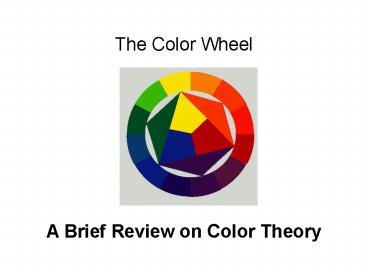The Color Wheel - PowerPoint PPT Presentation
1 / 10
Title:
The Color Wheel
Description:
The visual response to the wavelengths of sunlight identified as red, green, ... of yellow-green in the leaves and several variations of red-purple in the orchid. ... – PowerPoint PPT presentation
Number of Views:24
Avg rating:3.0/5.0
Title: The Color Wheel
1
The Color Wheel
A Brief Review on Color Theory
2
Color
The visual response to the wavelengths of
sunlight identified as red, green, blue and so
on having the physical properties of hue,
intensity, and value.
3
PRIMARY COLORS
Primary colors are colors from which all other
colors are made.
RED
BLUE
YELLOW
SECONDARY COLORS
Secondary colors that are created from equal
amounts of a pair of primary colors
ORANGE
GREEN
VIOLET
4
Tertiary Colors
Tertiary colors are colors made from equal
amounts of a pair of primary and secondary colors.
red-violet blue-violet blue-green
yellow-green yellow-orange red-orange
5
Analogous colors
Analogous colors are any three colors which are
side by side on a 12 part color wheel, such as
yellow-green, yellow, and yellow-orange.
Three consecutive colors on the color wheel
6
Complementary Colors
Complementary colors are any two colors which are
directly opposite each other in the color wheel.
Examples are red and green, red-purple and
yellow-green. In the illustration, there are
several variations of yellow-green in the leaves
and several variations of red-purple in the
orchid.
7
TINT
Tints are light values of a color. One usually
makes tints by mixing a color with different
amounts of white.
SHADE
Shades are dark values of a color. One usually
makes shades by mixing a color with different
amounts of black.
8
Monochromatic
A Monochromatic color scheme is one color.
The primary color is integrated with neutral
colors such as black, white, or gray.
9
SPLIT COMPLEMENTARY
The split complementary scheme is a variation of
the standard complementary scheme. It uses a
color and the two colors adjacent to its
complementary color.
Triadic Color Scheme
The triadic color scheme uses three colors
equally spaced around the color wheel.
10
Lets review what we just learned on our
handhelds.
1. Open up the color review for students
PowerPoint in Docs-To-Go
2. Open it and answer the questions using the
list view.
3. We will review it together































